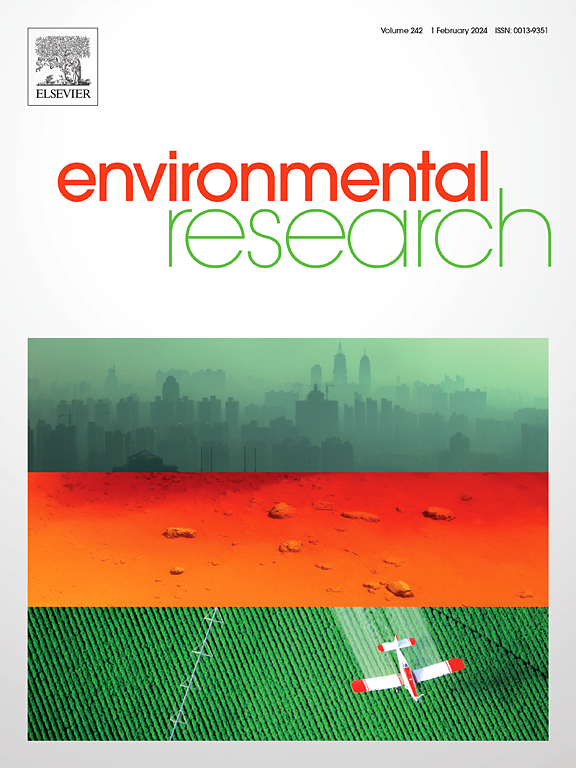使用不同长期暴露评估建模方法估算空气污染死亡率影响的比较
IF 7.7
2区 环境科学与生态学
Q1 ENVIRONMENTAL SCIENCES
引用次数: 0
摘要
流行病学研究使用了不同的方法来评估长期暴露于环境空气污染。在这些研究中,人们对不同的暴露模式如何影响健康影响估计知之甚少。本研究的目的是比较荷兰一个行政队列中基于不同暴露评估方法对黑碳(BC)、二氧化氮(NO2)、超细颗粒(UFP)和2.5 μm颗粒物(PM2.5)的空气污染死亡率影响估计。方法采用8种不同建模和监测策略的方法估计每年平均空气污染暴露,应用于荷兰1070万≥30岁成年人的国家队列。评估了基于移动和固定站点监测的分散和土地利用回归模型。随访时间为2013年至2019年。使用Cox比例风险模型估计自然死亡率和原因特异性死亡率的风险比(HR)。结果不同模型的暴露估计值高度相关。尽管两种方法的死亡率效应估计方向相似,但其量级差异很大,例如,每增加1 μg/m3,自然死亡率的BC的HR为1.01至1.09。在确定性和经验固定地点和移动模型之间没有发现效应估计的一致差异。10年期间的模型预测高度相关,并得出相似的hr。不同的暴露模型得出了与死亡率相关的相似结论,但hr差异高达1.27。因此,暴露评估的差异可能导致流行病学研究系统回顾中观察到的死亡率估计的异质性。本文章由计算机程序翻译,如有差异,请以英文原文为准。
Comparison of air pollution mortality effect estimates using different long-term exposure assessment modelling methods
Introduction
Epidemiological studies have used different approaches to assess long-term exposure to ambient air pollution. Little is known about how different exposure models affect health effect estimates in these studies. The aim of this study was to compare air pollution mortality effect estimates in an administrative cohort in the Netherlands based on different exposure assessment methods for black carbon (BC), nitrogen dioxide (NO2), ultrafine particles (UFP), and particulate matter <2.5 μm (PM2.5).
Methods
Annual average air pollution exposure estimates using eight methods, differing in modelling and monitoring strategy, were applied to a Dutch national cohort of 10.7 million adults aged ≥30 years. Dispersion and land-use regression models based on mobile and fixed-site monitoring were evaluated. Follow-up was from 2013 to 2019. Hazard ratios (HR) for natural and cause-specific mortality were estimated using Cox proportional hazards models.
Results
Exposure estimates from different models were highly correlated. Even though the direction of mortality effect estimates was similar between methods, their magnitude differed substantially, e.g. the HR for BC with natural mortality ranged from 1.01 to 1.09 per increment of 1 μg/m3. No consistent differences in effect estimates were found between deterministic and empirical fixed-site and mobile models. Model predictions over a 10-year period correlated highly and resulted in similar HRs.
Discussion
Different exposure models resulted in similar conclusions about the presence of associations with mortality, but HRs differed up to a ratio of 1.27. Differences in exposure assessment may therefore contribute to the observed heterogeneity of mortality estimates in systematic reviews of epidemiological studies.
求助全文
通过发布文献求助,成功后即可免费获取论文全文。
去求助
来源期刊

Environmental Research
环境科学-公共卫生、环境卫生与职业卫生
CiteScore
12.60
自引率
8.40%
发文量
2480
审稿时长
4.7 months
期刊介绍:
The Environmental Research journal presents a broad range of interdisciplinary research, focused on addressing worldwide environmental concerns and featuring innovative findings. Our publication strives to explore relevant anthropogenic issues across various environmental sectors, showcasing practical applications in real-life settings.
 求助内容:
求助内容: 应助结果提醒方式:
应助结果提醒方式:


